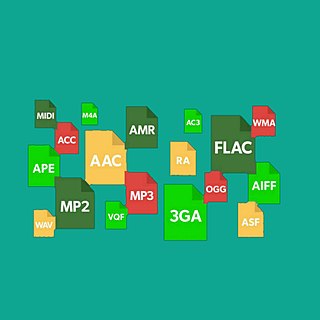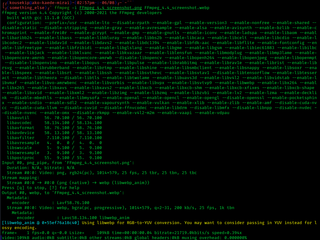Related Research Articles

An audio file format is a file format for storing digital audio data on a computer system. The bit layout of the audio data is called the audio coding format and can be uncompressed, or compressed to reduce the file size, often using lossy compression. The data can be a raw bitstream in an audio coding format, but it is usually embedded in a container format or an audio data format with defined storage layer.
A codec is a device or computer program that encodes or decodes a data stream or signal. Codec is a portmanteau of coder/decoder.

Ogg is a free, open container format maintained by the Xiph.Org Foundation. The authors of the Ogg format state that it is unrestricted by software patents and is designed to provide for efficient streaming and manipulation of high-quality digital multimedia. Its name is derived from "ogging", jargon from the computer game Netrek.
Audio Video Interleave is a proprietary multimedia container format and Windows standard introduced by Microsoft in November 1992 as part of its Video for Windows software. AVI files can contain both audio and video data in a file container that allows synchronous audio-with-video playback. Like the DVD video format, AVI files support multiple streaming audio and video, although these features are seldom used.

FLAC is an audio coding format for lossless compression of digital audio, developed by the Xiph.Org Foundation, and is also the name of the free software project producing the FLAC tools, the reference software package that includes a codec implementation. Digital audio compressed by FLAC's algorithm can typically be reduced to between 50 and 70 percent of its original size and decompresses to an identical copy of the original audio data.
Theora is a free lossy video compression format. It was developed by the Xiph.Org Foundation and distributed without licensing fees alongside their other free and open media projects, including the Vorbis audio format and the Ogg container.

FFmpeg is a free and open-source software project consisting of a suite of libraries and programs for handling video, audio, and other multimedia files and streams. At its core is the command-line ffmpeg tool itself, designed for processing of video and audio files. It is widely used for format transcoding, basic editing, video scaling, video post-production effects and standards compliance.
Windows Media Video (WMV) is a series of video codecs and their corresponding video coding formats developed by Microsoft. It is part of the Windows Media framework. WMV consists of three distinct codecs: The original video compression technology known as WMV, was originally designed for Internet streaming applications, as a competitor to RealVideo. The other compression technologies, WMV Screen and WMV Image, cater for specialized content. After standardization by the Society of Motion Picture and Television Engineers (SMPTE), WMV version 9 was adapted for physical-delivery formats such as HD DVD and Blu-ray Disc and became known as VC-1. Microsoft also developed a digital container format called Advanced Systems Format to store video encoded by Windows Media Video.
RealVideo, or also spelled as Real Video, is a suite of proprietary video compression formats developed by RealNetworks — the specific format changes with the version. It was first released in 1997 and as of 2008 was at version 10. RealVideo is supported on many platforms, including Windows, Mac, Linux, Solaris, and several mobile phones.

Smacker video is a video file format developed by Epic Games Tools, and primarily used for full-motion video in video games. Smacker uses an adaptive 8-bit RGB palette. RAD's format for video at higher color depths is Bink Video. The Smacker format specifies a container format, a video compression format, and an audio compression format. Since its release in 1994, Smacker has been used in over 2300 games. Blizzard used this format for the cinematic videos seen in its games Warcraft II, StarCraft and Diablo I.
A FourCC is a sequence of four bytes used to uniquely identify data formats. It originated from the OSType or ResType metadata system used in classic Mac OS and was adopted for the Amiga/Electronic Arts Interchange File Format and derivatives. The idea was later reused to identify compressed data types in QuickTime and DirectShow.
A container format or metafile is a file format that allows multiple data streams to be embedded into a single file, usually along with metadata for identifying and further detailing those streams. Notable examples of container formats include archive files and formats used for multimedia playback. Among the earliest cross-platform container formats were Distinguished Encoding Rules and the 1985 Interchange File Format.
These tables compare features of multimedia container formats, most often used for storing or streaming digital video or digital audio content. To see which multimedia players support which container format, look at comparison of media players.
FAAC is a software project which includes the AAC encoder FAAC and decoder FAAD2. It supports MPEG-2 AAC as well as MPEG-4 AAC. It supports several MPEG-4 Audio object types, file formats, multichannel and gapless encoding/decoding and MP4 metadata tags. The encoder and decoder is compatible with standard-compliant audio applications using one or more of these object types and facilities. It also supports Digital Radio Mondiale.
Flash Video is a container file format used to deliver digital video content over the Internet using Adobe Flash Player version 6 and newer. Flash Video content may also be embedded within SWF files. There are two different Flash Video file formats: FLV and F4V. The audio and video data within FLV files are encoded in the same way as SWF files. The F4V file format is based on the ISO base media file format, starting with Flash Player 9 update 3. Both formats are supported in Adobe Flash Player and developed by Adobe Systems. FLV was originally developed by Macromedia. In the early 2000s, Flash Video was the de facto standard for web-based streaming video. Users include Hulu, VEVO, Yahoo! Video, metacafe, Reuters.com, and many other news providers.
MPEG-4 Audio Lossless Coding, also known as MPEG-4 ALS, is an extension to the MPEG-4 Part 3 audio standard to allow lossless audio compression. The extension was finalized in December 2005 and published as ISO/IEC 14496-3:2005/Amd 2:2006 in 2006. The latest description of MPEG-4 ALS was published as subpart 11 of the MPEG-4 Audio standard in December 2019.
AMV is a proprietary video file format, produced for MP4 players, as well as S1 MP3 players with video playback. There are two different versions of this format: an older one for Actions chips, and a newer one for ALi's M5661 chip, sometimes called ALIAVI.
Asao is a proprietary single-channel (mono) codec and compression format optimized for low-bitrate transmission of audio, developed by Nellymoser Inc.

Libav is an abandoned free software project, forked from FFmpeg in 2011, that contains libraries and programs for handling multimedia data.
References
- ↑ "Google's YouTube Uses FFmpeg | Breaking Eggs And Making Omelettes". multimedia.cx. 9 February 2011.
- ↑ Kaourantin.net (31 October 2007) Tinic Uro New File Extensions and MIME Types Archived 2010-07-06 at the Wayback Machine , Retrieved on 2009-08-03
- 1 2 "QuickTime File Format". www.digitalpreservation.gov. 2013-02-14.
- ↑ "AMV codec tools" code.google.com
- ↑ "RoQ - MultimediaWiki". wiki.multimedia.cx.